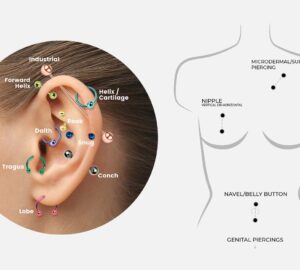Adding a little spunk to your ears can go a long, long way! If you’re a fan of piercings, you know how much fun it can be to get cartilage piercings. With a wide surface area, the cartilage offers a number of piercing opportunities. One piercing that makes a great addition to the cartilage is a helix piercing.
The helix isn’t limited to only one piercing; you can get two, three, and even multiple piercings to form a long queue of beautiful jewelry along with your ear.
Without further ado, let’s have a look at everything you need to know about helix piercings.
What Is a Helix Piercing?
In simple words, a helix piercing is one that is located at the upper portion of the rim of the ear. While it can be quite complicated to understand the anatomy of the ear, the piercing is the simplest one to understand after earlobe piercings. Tracing the top line of the ear that connects to your face down to the middle edge of your ear till your lobe is the prime helix piercing location.
Difference between Helix Piercings and Cartilage Piercings
Many people are unable to distinguish between cartilage and helix piercings. Technically, they’re both one in the same thing. A cartilage piercing is a general term and is used to define piercings that go through your cartilage. Cartilage piercings may range from nostril piercings to daith piercings.
A helix piercing is a type of cartilage piercing that is placed alongside the rim of your ear. Since the helix piercing is the most famous type of cartilage piercing, both terms are now used interchangeably.
So, if you go to get a cartilage piercing, don’t be surprised if the piercing specialist asks you which cartilage piercing you would like to get.
What Should I Know Before Getting a Helix Piercing?
Just like any other piercing, make sure that your piercer is certified, trained, and experienced. Never visit a random piercing store at the mall as most piercers there aren’t experienced or certified. Moreover, before deciding on a piercing studio, pay them a visit to see how they conduct piercings. Every specialized piercer will use clean disposable gloves and sterilized tools for your piercing.
Since the cartilage is a little harder than other areas, such as the earlobe, it takes some time for it to heal. The cells of your cartilage don’t regenerate like other tissues, which it is difficult for the cartilage to heal by itself. Using a piercing gun for a helix piercing can be damaging for your cartilage as a piercing gun uses blunt force to shove the jewelry in your ear.
How Many Helix Piercings Can I Get?
You don’t need to stick to a single helix piercing. If you want, you can go big by getting multiple helix piercings. Here are a few ways you can rock this fantastic cartilage piercing.
Single Helix Piercing
If you don’t want something too flashy, a single and simple helix piercing in the upper portion of the rim is a perfect choice. Even though it gives a little hint of rebellion, this piercing doesn’t draw too much attention. It also allows for various jewelry types, with the most basic ones being dainty pins to fancy options such as spiral barbells.
Double Helix Piercing
Two is always better than one! Since the helix offers a huge surface area for piercings, you can get double helix piercings that are either close to each other, far apart or anything else that suits you!
Triple Helix Piercing
If you love helix piercings as much as we do, go for the triple helix piercing! You can pull off this piercing trifecta by opting for a simple look with dainty studs or you can opt for more extravagant jewelry choices.
The only factor that limits the number of helix piercings you can get is – the size of your ear. If you want to get some super cool looks, then turn to helix piercings.




